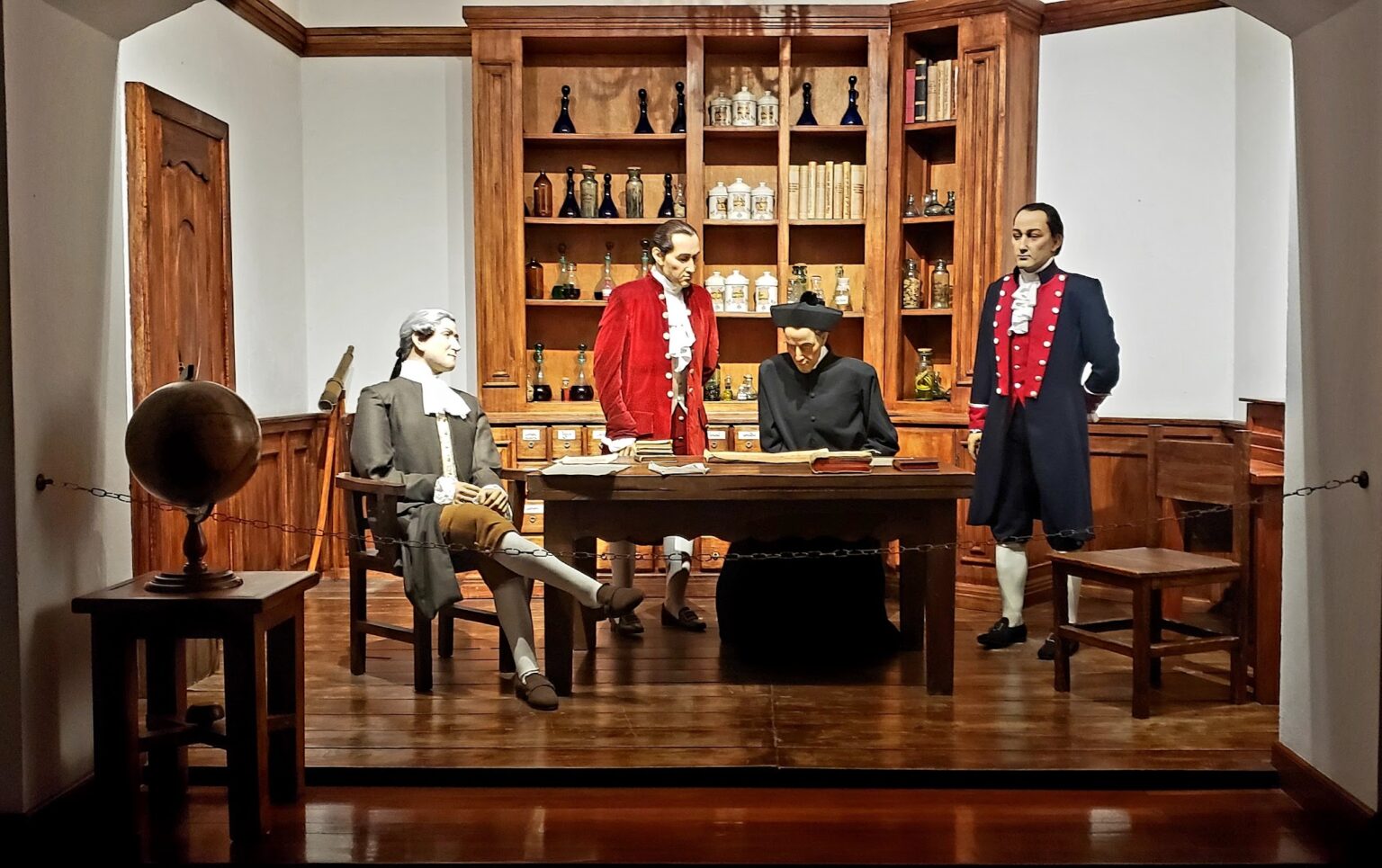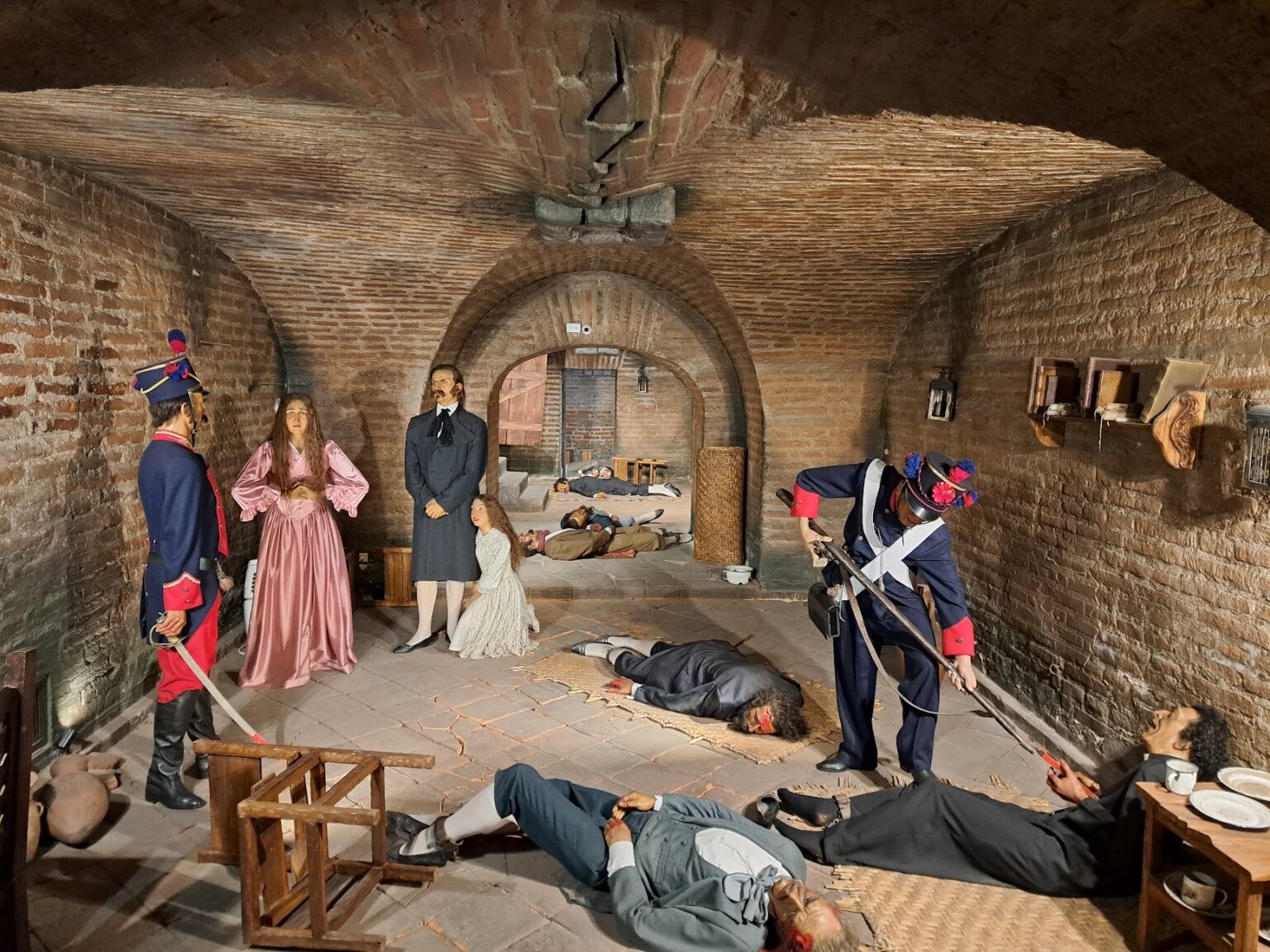Español
El Museo Alberto Mena Caamaño fue creado el 28 de mayo de 1957 gracias a la donación del filántropo quiteño que le da nombre, quien entregó más de 600 piezas entre esculturas, pinturas, armas y objetos arqueológicos. El museo abrió sus puertas en 1959 en el edificio del antiguo Cuartel Real de Lima. En 1970 incorporó la célebre sala de cera sobre la masacre del 2 de agosto de 1810, lo que le dio el nombre popular de «Museo de Cera». Hoy ofrece exposiciones permanentes y temporales, además de espacios educativos y culturales.
La sede del museo es el antiguo Cuartel Real de Lima, edificado a finales del siglo XVI como centro militar de la Real Audiencia de Quito. Sus calabozos fueron temidos en época colonial y en ellos estuvieron presos personajes como Eugenio Espejo. En el siglo XIX sirvió como Cuartel de Quito y luego como centro de detención. El inmueble fue restaurado varias veces, destacando las obras de 1958-59 y las rehabilitaciones posteriores a los daños del sismo de 1987, hasta su reapertura definitiva en 2002.
El edificio combina materiales coloniales como adobe y madera con remodelaciones de los siglos XIX y XX. En su restauración se reforzó la estructura con acero y concreto, se instaló cableado y se embelleció con una fuente, un jardín afrancesado y piedra ornamental en la fachada. Estos elementos lo convierten en un referente patrimonial de la ciudad, manteniendo la esencia de su origen militar y colonial.
Actualmente el museo cuenta con más de 5.800 piezas. Entre ellas: fondos arqueológicos, pictóricos (con obras de Miguel de Santiago, Samaniego, Rodríguez, Troya, Pinto, entre otros), escultóricos coloniales, documentales, textiles, metalúrgicos, decorativos, tecnológicos y misceláneos. Su fondo más llamativo son las figuras de cera que recrean escenas y personajes del proceso independentista.
La muestra principal se titula “De Quito al Ecuador (1736-1830)”, que narra la historia de la ciudad desde la llegada de la misión geodésica hasta la independencia y anexión a la Gran Colombia. Se organiza en diez capítulos temáticos e incluye la recreación de la Masacre del 2 de agosto de 1810. Combina figuras de cera con el resto de colecciones del museo para brindar una visión integral de la historia de Quito y del Ecuador.


English
History of the Museum
The Alberto Mena Caamaño Museum was established on May 28, 1957, thanks to a donation from the Quito philanthropist who gave it its name, who donated more than 600 pieces, including sculptures, paintings, weapons, and archaeological objects. The museum opened in 1959 in the building of the former Royal Barracks of Lima. In 1970, it added the famous wax room dedicated to the massacre of August 2, 1810, giving it the popular name «Wax Museum.» Today, it offers permanent and temporary exhibitions, as well as educational and cultural spaces.
History of the Building
The museum is located in the former Royal Barracks of Lima, built in the late 16th century as a military center for the Royal Audience of Quito. Its dungeons were feared during the colonial era and held figures such as Eugenio Espejo. In the 19th century, it served as the Quito Barracks and later as a detention center. The building was restored several times, with notable works from 1958-59 and renovations following the damage caused by the 1987 earthquake, until its final reopening in 2002.
Architecture
The building combines colonial materials such as adobe and wood with 19th and 20th-century renovations. During its restoration, the structure was reinforced with steel and concrete, wiring was installed, and the facade was embellished with a fountain, a French-style garden, and ornamental stonework. These elements make it a landmark of the city’s heritage, maintaining the essence of its military and colonial origins.
Collection
The museum currently houses more than 5,800 pieces. These include archaeological collections, paintings (with works by Miguel de Santiago, Samaniego, Rodríguez, Troya, Pinto, among others), colonial sculptures, documentaries, textiles, metalwork, decorative objects, technological objects, and miscellaneous items. Its most striking collection is the wax figures recreating scenes and figures from the independence movement.
Permanent Exhibition
The main exhibition is titled «From Quito to Ecuador (1736-1830),» which tells the history of the city from the arrival of the geodesic mission to its independence and annexation to Gran Colombia. It is organized into ten thematic chapters and includes a reenactment of the Massacre of August 2, 1810. It combines wax figures with the rest of the museum’s collections to provide a comprehensive overview of the history of Quito and Ecuador.